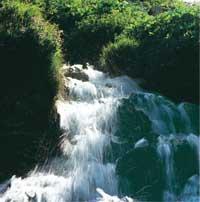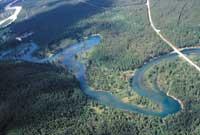New approach to sustainable water management
2002/05/12 Mendiburu, Joana - Elhuyar Zientziaren Komunikazioa
One of the most widespread and disturbing problems worldwide is water management. And fortunately, the administration, institutions, and citizenship are becoming aware of the importance of water. But, unfortunately, one cannot say that one pays attention to the problem. There is still much to do to recover and protect the quality of water and, among other things, the European Union underlines the need to overcome administrative and political limits. This is at least one of the main objectives of the new directive.
The new European water directive represents a change in basic policy to achieve sustainable water management. For the first time, the protection of all aquatic ecosystems will be reflected in a single directive. In addition, the countries of the European Union must have a broader view of water protection, overcoming political and administrative limits and working in the watersheds.
Long history behind
The European Union regulations have been advancing since 1975 with the aim of improving water quality and management. Thus, for about twenty years, a dozen directives have been approved to combat the types of water pollution. But among so many directives more than one has been drowned and their results have not been as spectacular as expected. Therefore, the need for a new approach is clear.

On the one hand, the problem of water should be addressed from a broader perspective (taking into account the interaction of different types of pollution) and, on the other, collaboration between administrations is fundamental. To materialize this idea, after three years of negotiations, the Water Framework Directive was approved on March 23, 2000.
This directive covers all community waters (surface and underground continental, transitional and coastal). The goal will be to protect aquatic ecosystems and improve current situations. Deadline 2015. By then, the quality of the waters at all levels should be adequate.
How to define the quality of water?
The directive establishes criteria for measuring water quality. In the case of surface waters (lakes, rivers, etc.) will take into account its ecological and chemical state. The diversity and number of species, the concentration of oxygen, the temperature, the quantity of water, etc. They will be measured. The chemical state can be observed by measuring the levels of polluting agents.
In the case of underground waters, basic parameters such as oxygen, conductivity, pH, nitrates, etc should be controlled. If it is observed that water quality is worsening based on these parameters, measures should be taken to avoid it. The amount must be taken into account. That is, the amount of water that leaves the subsoil will be measured. The quality will be defined taking into account the balance of the quantity and influence of the pollutants.
Working in the hydrographic basin
The main novelty of this directive is that water management is based on the hydrographic basin. To carry out sustainable management, it is essential to make decisions in the river basin and not on the basis, as so far, of administrative and political limitations. In cases where the river or river crosses national borders, an international hydrographic delimitation must be established and countries must cooperate. In the case of the Danube or Elba rivers, management agreements are already underway.
For this purpose, the directive has set deadlines. By 2003, each country should identify the watersheds and establish a hydrographic delimitation, as well as designate a suitable organism for the application of the rules established in the directive. The information relating to all the water masses will then be collected and its classification will proceed. By 2004, the impact of human activities should also be fixed and the compliance of environmental objectives should be controlled.
Subsequently, from the studies carried out, the hydrological plan of the basin should be established. In this plan, the objectives to be achieved will be designated. The calendar of the work programme for 2008 will be announced and the drafts of opinion and suggestions of the public and all interested people will be made public.
To achieve a good quality of water and aquatic ecosystems, the countries of the European Union have until 2015. Although in principle it seems a long term, it should be taken into account that the directive proposes a water management that had never been proposed so far. There are many sectors involved: administrations, institutions, farmers, fishermen, individuals… The collaboration of all will be fundamental and that is the greatest difficulty. But it is clear that it will be as difficult as it is essential, and in addition, to improve the quality of water, participation of all is essential.
Published in the Gara Station Supplement.

Gai honi buruzko eduki gehiago
Elhuyarrek garatutako teknologia






